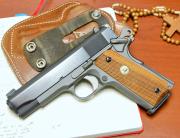The video from Caleb's article helped me understand the definitions alot and I now reckon to be definitely indexed based.
I've definitely not found Todd's listed potential shortcomings to be a problem. For example when drawing up against an obstruction, I've never rammed the gun into it.









